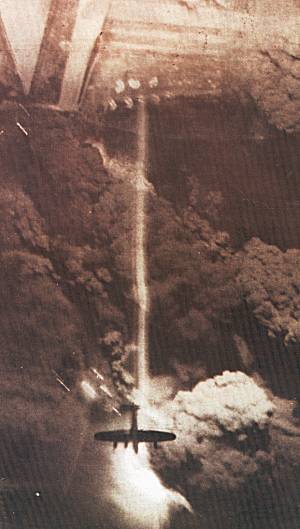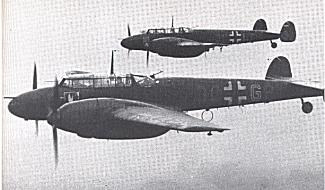
Durante la Grande Guerra si erano effettuate delle esperienze
di Caccia notturna, ma con la fine del conflitto quelle
esperienze vennero perdute. Tuttavia durante gli anni trenta, la
tecnologia nello studio e nello sviluppo di apparecchiature radar
aveva portato a produrre apparecchiature gigantesche, ma
sostanzialmente funzionanti. Alcuni studi avevano proposto lo
sviluppo di apparecchiature aerotrasportabili, ma poca spinta
venne data in quella direzione.
Con lo scoppio della Seconda Guerra Mondiale e con il conseguente
inizio delle operazioni di bombardamento del territorio tedesco,
da parte dell'aviazione inglese, si rese necessario contrastare i
bombardieri notturni che scorrazzavano in lungo e in largo
sull'Europa centrale.
Divenne quindi indispensabile la creazione di reparti adeguati
alla Caccia Notturna. La basi vennero gettate dal Capitano
Wolfgang Falk che alla fine di Aprile del 1940, nella base del
suo ZG 1,
pensò concretamente a come contrastare i velivoli inglesi
che sorvolavano la Danimarca ogni notte. Il 26 giugno del 1940, alla presenza di Goering,
Kesselring, Kastner e Udet, viene fondato il Nacht JagdGeshwadern
1 (NJG 1), ma le
crescenti difficoltà operative stavano portando il reparto
al suo scioglimento.
Il 26 giugno del 1940, alla presenza di Goering,
Kesselring, Kastner e Udet, viene fondato il Nacht JagdGeshwadern
1 (NJG 1), ma le
crescenti difficoltà operative stavano portando il reparto
al suo scioglimento.
All'inizio del 1941 la CN era stata organizzata in
sezioni operative. Queste (18) coprivano una fascia territoriale
di oltre 800 Km. in larghezza e 35 in profondità.
Ogni sezione aveva proiettori, radar e 3 aerei a disposizione. Il
radar Freya a lungo raggio era dislocato in testa alla sezione,
mentre altri 4 radar Wurzburg passando le informazioni alle
stazioni di proiettori, facevano si che gli avversari fossero
illuminati e soggetti all'azione di due caccia (Bf 110 C e/o
D).
Questo sistema venne presto aggirato dagli inglesi e rapidamente
abbandonato.
 A questo
punto, siamo alla fine del 1941, nasce la caccia combinata
composta dall'azione della Flak e degli aerei. Le aree di
intervento erano stabilite intorno alle città di Kiel,
Brema, Duisburg, Colonia, Francoforte, Darmstadt, Mannheim e
Monaco ed ogni area era divisa in tre sezioni in ognuna delle
quali era presente un radar Freya a lungo raggio e due Wurzburg
Riese a corto raggio.
A questo
punto, siamo alla fine del 1941, nasce la caccia combinata
composta dall'azione della Flak e degli aerei. Le aree di
intervento erano stabilite intorno alle città di Kiel,
Brema, Duisburg, Colonia, Francoforte, Darmstadt, Mannheim e
Monaco ed ogni area era divisa in tre sezioni in ognuna delle
quali era presente un radar Freya a lungo raggio e due Wurzburg
Riese a corto raggio.
Quando i Wurzburg Riese avevano intercettato i nemici, passavano
le informazioni al comando contraereo che allertava la Flak e gli
aerei.
La Flak doveva limitarsi ai 4000 o agli 8000 metri se i caccia
non erano nei paraggi.
Malgrado una ferrea organizzazione, alcuni velivoli tedeschi
vennero abbattuti o danneggiati dalla Flak amica. Per questi
motivi venne presto abbandonata.


[ Continua ... ]
English version
The German Nocturnal Hunting in the Second World
war
During the Great War had been carried out of the experiences of
nocturnal Hunting, but with the end of the conflict those
experiences came lost. However during years thirty, the
technology in the study and the development of equipment radar
had carried to produce gigantic equipment, but substantially
working. Some studies had proposed the development of air
transportable equipment, but little push came given in that
direction.
With the explosion of the Second World war and with the
consequent beginning of the operations of strafing of the German
territory, from part of English aviation, yields necessary to
contrast the nocturnal bombers that run about central Europe. It
becomes therefore the creation of units indispensable adapts to
the Nocturnal Hunting. The bases came jetties from Captain
Wolfgang Falk who to the end of April of 1940, in the base of its
ZG 1, thought concretely to contrasting the English aircrafts
that flew over every Denmark night. The 26 june of 1940, to the
presence of Goering, Kesselring, Kastner and Udet, 1/NJG 1 comes
founded the Nacht JagdGeshwadern, but the crescents operating
difficulties were carrying the unit to its dissolution.
To the beginning of 1941 the CN had been organized in operating
sections. These (18) covered one wrap territorial of beyond 800
Km. in width and 35 in depth. Every section had floodlights,
radar and 3 airplane to disposition. The Freya radar to long
range was dislocated in head to the section, while others 4
Wurzburg radars having passed the information to the stations of
floodlights, made that the adversaries were illuminate and
subject to the action of two hunting (Bf 110 C and/or D). This
system came soon gone around from English and quickly abandoned.
To this point, we are to the end of 1941, is born the hunting
arranged composed from the action of the Flak and the airplane.
The participation areas were established around to the cities of
Kiel, Brema, Duisburg, Colony, Frankfurt, Darmstadt, Mannheim and
Monaco and every area a Freya radar to long range and two
Wurzburg Riese was uniform in three sections in everyone of
theses which was present short beam.
When the Wurzburg Riese had intercepted the enemies, the
information passed to the antiaircraft commando who warning the
Flak and the airplane. The Flak had to be limited to the 4000 or
the 8000 meters if the hunting were not in the environs. In spite
of an iron organization, some German aircrafts came pulled down
or damaged from the friend Flak. For these reasons it came soon
abandoned.
[ Continue ...
]